Grand Canyon University: Critical Decision Making for Providers Report
VerifiedAdded on 2023/01/18
|6
|1254
|27
Report
AI Summary
This report examines a case study involving a lab technician, Mike, who faces a critical decision: report a spill and risk being late for work, or ignore it. The report analyzes the potential consequences of both choices, including patient safety risks, financial implications for the healthcare facility, and potential legal actions. It emphasizes the importance of incident reporting and the adoption of evidence-based leadership and management to improve employee satisfaction and patient care. The report suggests remedies such as creating conducive working environments and fostering communication between management and staff to address similar issues and ensure quality healthcare services. The report also includes references to support its arguments and findings.
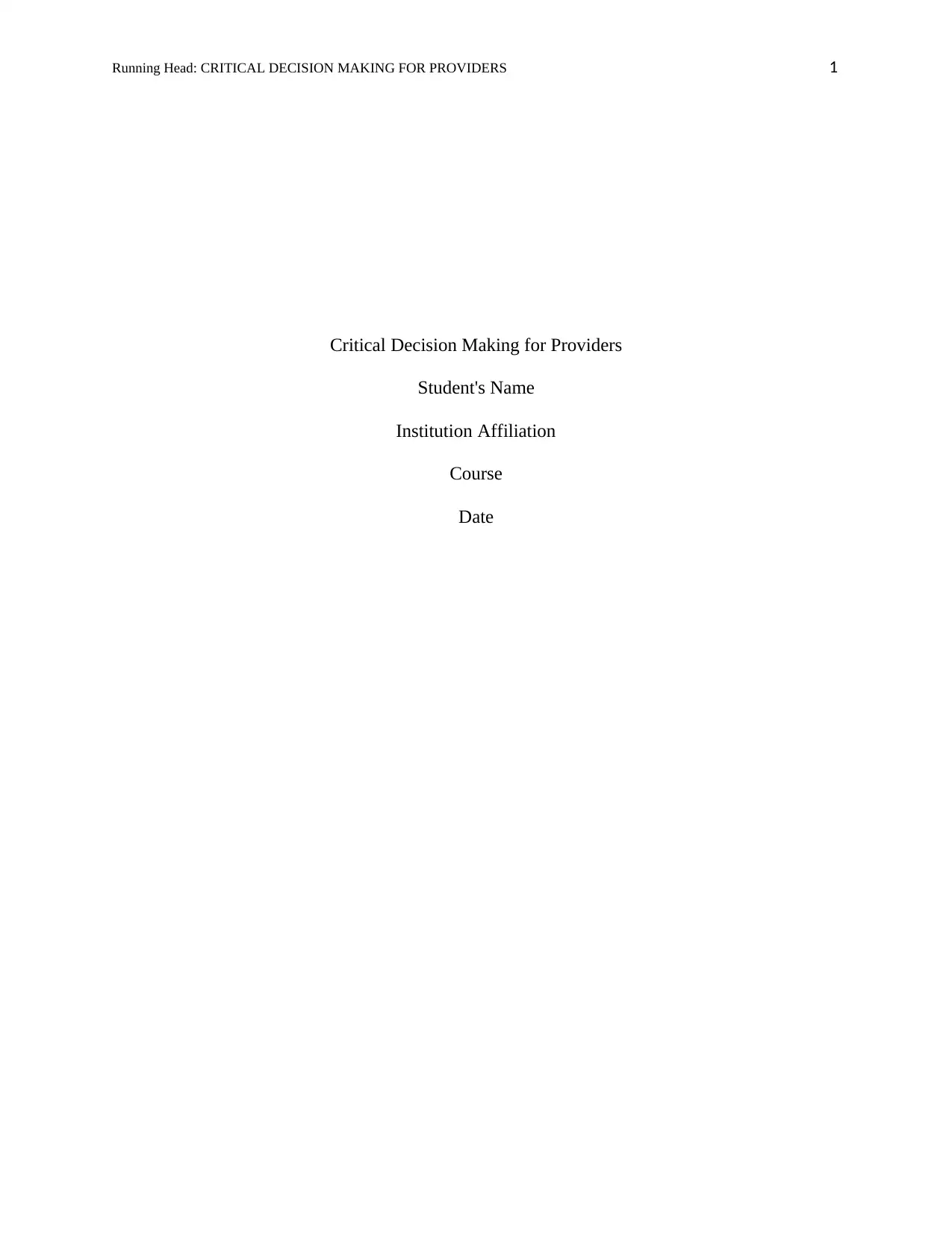
Running Head: CRITICAL DECISION MAKING FOR PROVIDERS 1
Critical Decision Making for Providers
Student's Name
Institution Affiliation
Course
Date
Critical Decision Making for Providers
Student's Name
Institution Affiliation
Course
Date
Paraphrase This Document
Need a fresh take? Get an instant paraphrase of this document with our AI Paraphraser
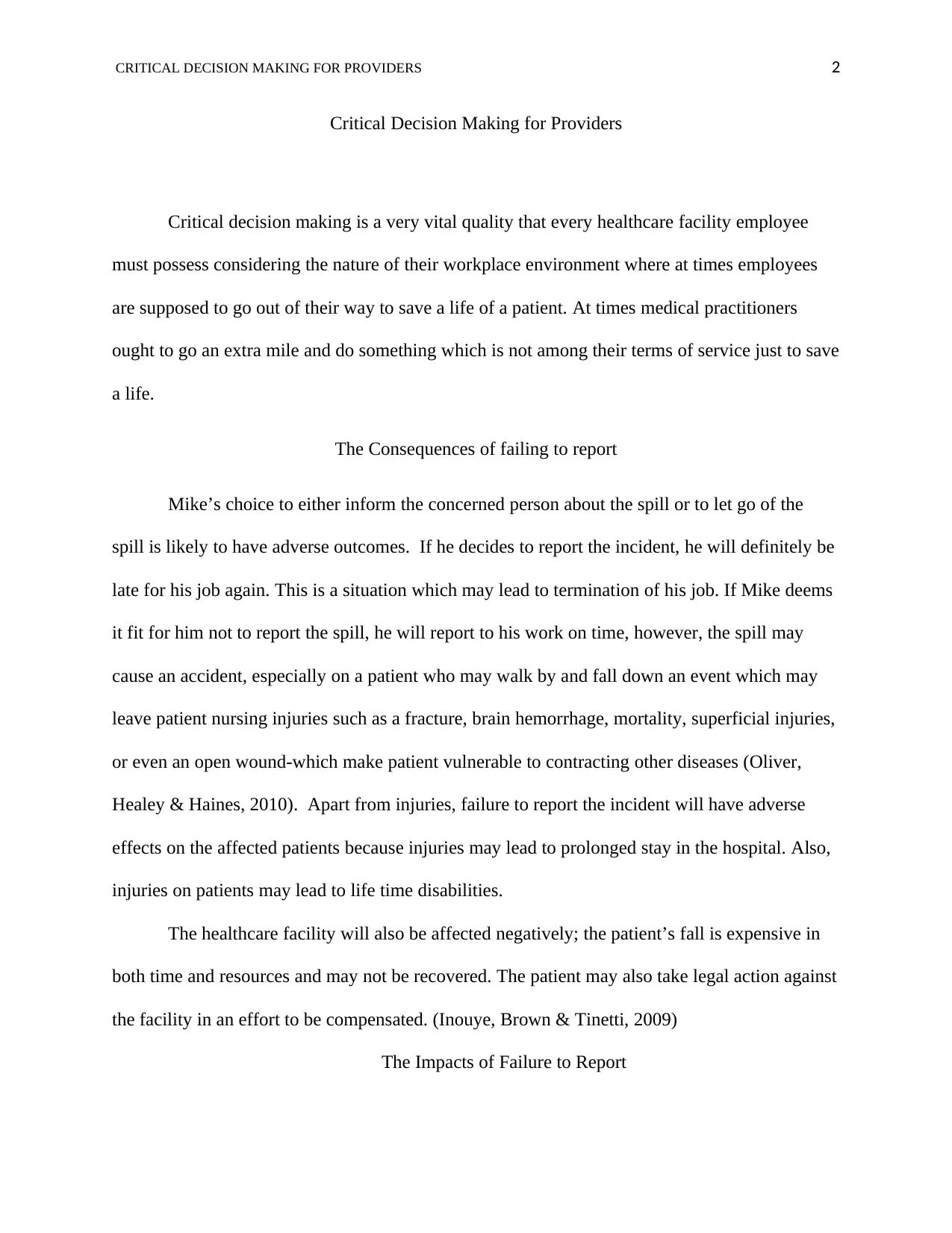
CRITICAL DECISION MAKING FOR PROVIDERS 2
Critical Decision Making for Providers
Critical decision making is a very vital quality that every healthcare facility employee
must possess considering the nature of their workplace environment where at times employees
are supposed to go out of their way to save a life of a patient. At times medical practitioners
ought to go an extra mile and do something which is not among their terms of service just to save
a life.
The Consequences of failing to report
Mike’s choice to either inform the concerned person about the spill or to let go of the
spill is likely to have adverse outcomes. If he decides to report the incident, he will definitely be
late for his job again. This is a situation which may lead to termination of his job. If Mike deems
it fit for him not to report the spill, he will report to his work on time, however, the spill may
cause an accident, especially on a patient who may walk by and fall down an event which may
leave patient nursing injuries such as a fracture, brain hemorrhage, mortality, superficial injuries,
or even an open wound-which make patient vulnerable to contracting other diseases (Oliver,
Healey & Haines, 2010). Apart from injuries, failure to report the incident will have adverse
effects on the affected patients because injuries may lead to prolonged stay in the hospital. Also,
injuries on patients may lead to life time disabilities.
The healthcare facility will also be affected negatively; the patient’s fall is expensive in
both time and resources and may not be recovered. The patient may also take legal action against
the facility in an effort to be compensated. (Inouye, Brown & Tinetti, 2009)
The Impacts of Failure to Report
Critical Decision Making for Providers
Critical decision making is a very vital quality that every healthcare facility employee
must possess considering the nature of their workplace environment where at times employees
are supposed to go out of their way to save a life of a patient. At times medical practitioners
ought to go an extra mile and do something which is not among their terms of service just to save
a life.
The Consequences of failing to report
Mike’s choice to either inform the concerned person about the spill or to let go of the
spill is likely to have adverse outcomes. If he decides to report the incident, he will definitely be
late for his job again. This is a situation which may lead to termination of his job. If Mike deems
it fit for him not to report the spill, he will report to his work on time, however, the spill may
cause an accident, especially on a patient who may walk by and fall down an event which may
leave patient nursing injuries such as a fracture, brain hemorrhage, mortality, superficial injuries,
or even an open wound-which make patient vulnerable to contracting other diseases (Oliver,
Healey & Haines, 2010). Apart from injuries, failure to report the incident will have adverse
effects on the affected patients because injuries may lead to prolonged stay in the hospital. Also,
injuries on patients may lead to life time disabilities.
The healthcare facility will also be affected negatively; the patient’s fall is expensive in
both time and resources and may not be recovered. The patient may also take legal action against
the facility in an effort to be compensated. (Inouye, Brown & Tinetti, 2009)
The Impacts of Failure to Report
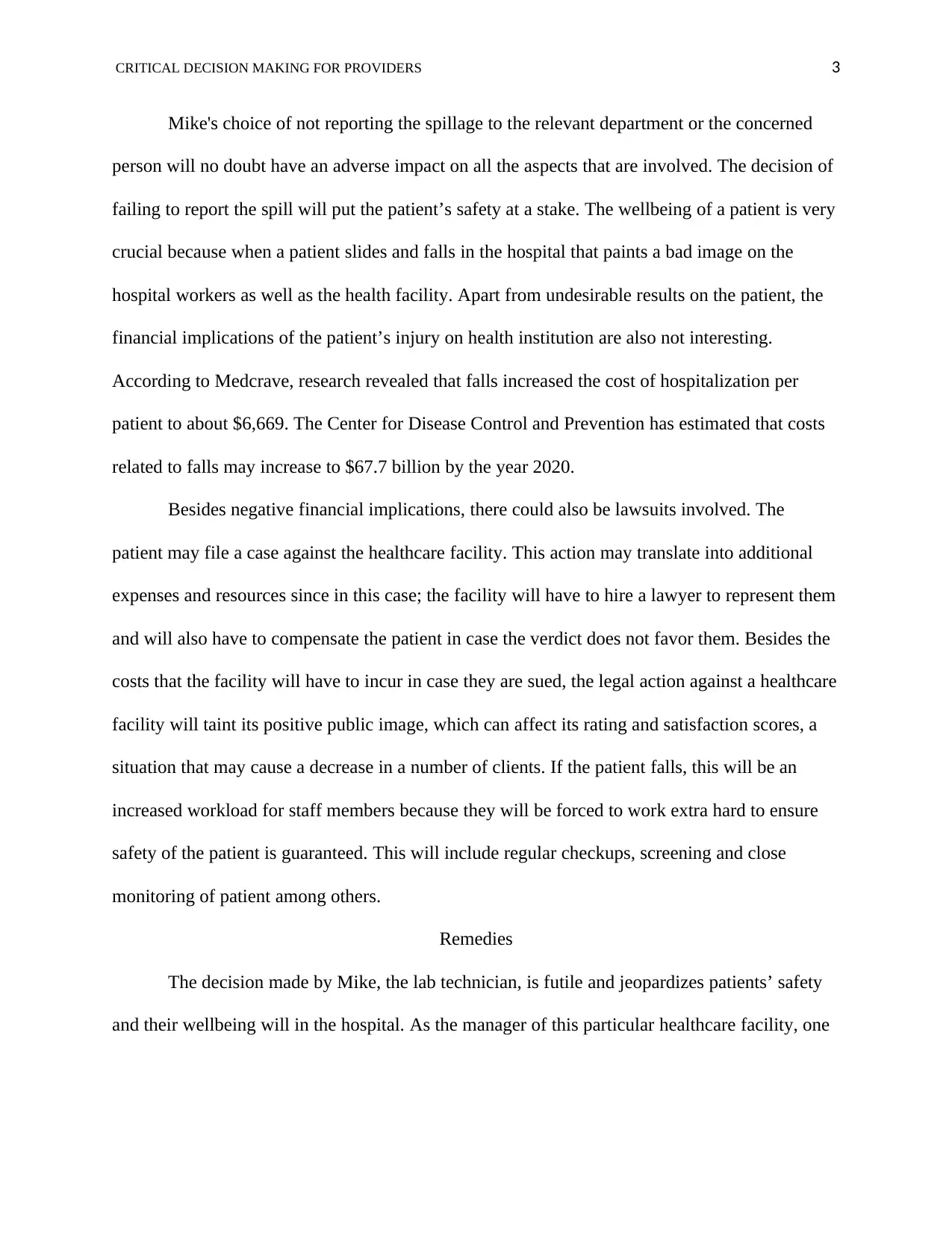
CRITICAL DECISION MAKING FOR PROVIDERS 3
Mike's choice of not reporting the spillage to the relevant department or the concerned
person will no doubt have an adverse impact on all the aspects that are involved. The decision of
failing to report the spill will put the patient’s safety at a stake. The wellbeing of a patient is very
crucial because when a patient slides and falls in the hospital that paints a bad image on the
hospital workers as well as the health facility. Apart from undesirable results on the patient, the
financial implications of the patient’s injury on health institution are also not interesting.
According to Medcrave, research revealed that falls increased the cost of hospitalization per
patient to about $6,669. The Center for Disease Control and Prevention has estimated that costs
related to falls may increase to $67.7 billion by the year 2020.
Besides negative financial implications, there could also be lawsuits involved. The
patient may file a case against the healthcare facility. This action may translate into additional
expenses and resources since in this case; the facility will have to hire a lawyer to represent them
and will also have to compensate the patient in case the verdict does not favor them. Besides the
costs that the facility will have to incur in case they are sued, the legal action against a healthcare
facility will taint its positive public image, which can affect its rating and satisfaction scores, a
situation that may cause a decrease in a number of clients. If the patient falls, this will be an
increased workload for staff members because they will be forced to work extra hard to ensure
safety of the patient is guaranteed. This will include regular checkups, screening and close
monitoring of patient among others.
Remedies
The decision made by Mike, the lab technician, is futile and jeopardizes patients’ safety
and their wellbeing will in the hospital. As the manager of this particular healthcare facility, one
Mike's choice of not reporting the spillage to the relevant department or the concerned
person will no doubt have an adverse impact on all the aspects that are involved. The decision of
failing to report the spill will put the patient’s safety at a stake. The wellbeing of a patient is very
crucial because when a patient slides and falls in the hospital that paints a bad image on the
hospital workers as well as the health facility. Apart from undesirable results on the patient, the
financial implications of the patient’s injury on health institution are also not interesting.
According to Medcrave, research revealed that falls increased the cost of hospitalization per
patient to about $6,669. The Center for Disease Control and Prevention has estimated that costs
related to falls may increase to $67.7 billion by the year 2020.
Besides negative financial implications, there could also be lawsuits involved. The
patient may file a case against the healthcare facility. This action may translate into additional
expenses and resources since in this case; the facility will have to hire a lawyer to represent them
and will also have to compensate the patient in case the verdict does not favor them. Besides the
costs that the facility will have to incur in case they are sued, the legal action against a healthcare
facility will taint its positive public image, which can affect its rating and satisfaction scores, a
situation that may cause a decrease in a number of clients. If the patient falls, this will be an
increased workload for staff members because they will be forced to work extra hard to ensure
safety of the patient is guaranteed. This will include regular checkups, screening and close
monitoring of patient among others.
Remedies
The decision made by Mike, the lab technician, is futile and jeopardizes patients’ safety
and their wellbeing will in the hospital. As the manager of this particular healthcare facility, one
⊘ This is a preview!⊘
Do you want full access?
Subscribe today to unlock all pages.

Trusted by 1+ million students worldwide
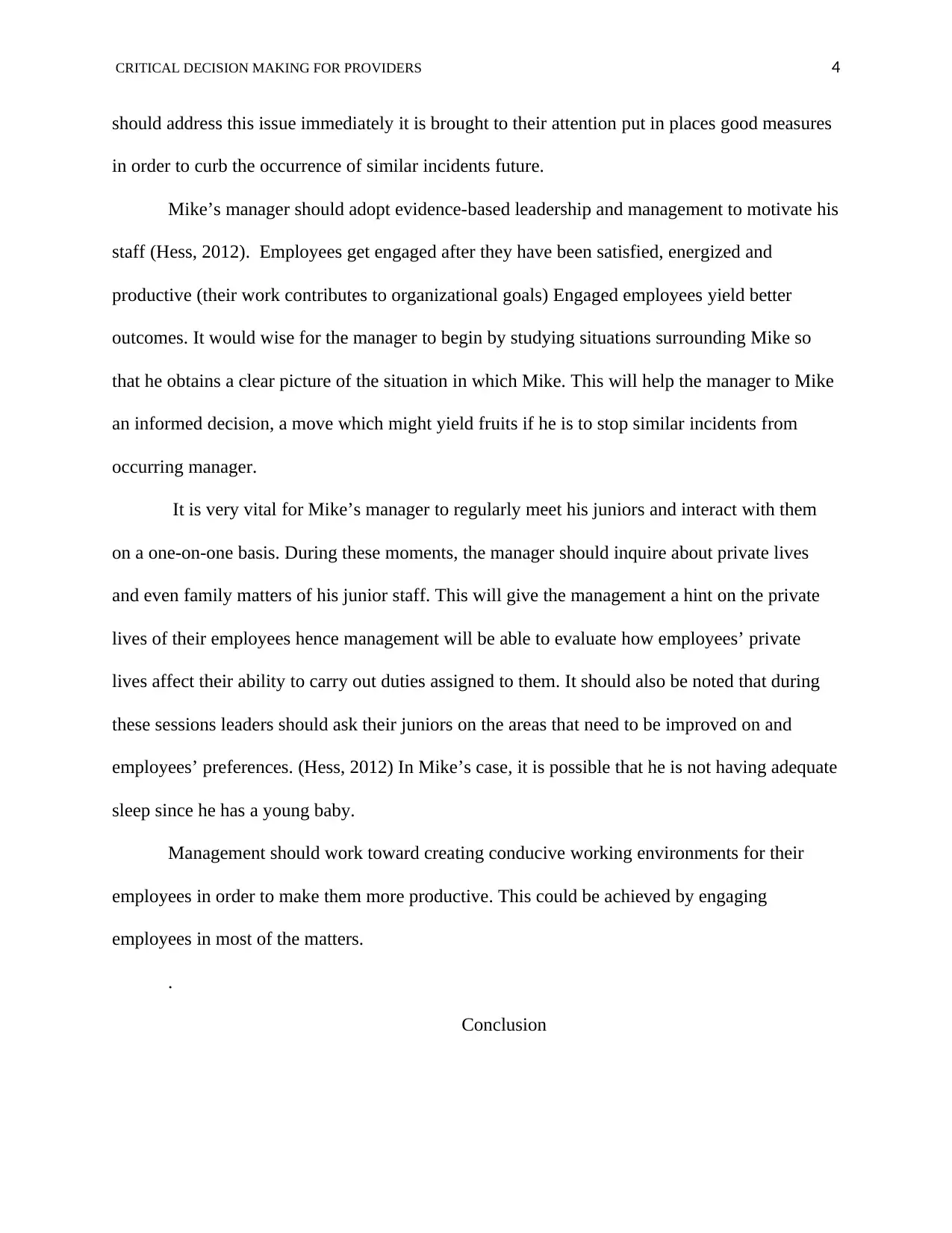
CRITICAL DECISION MAKING FOR PROVIDERS 4
should address this issue immediately it is brought to their attention put in places good measures
in order to curb the occurrence of similar incidents future.
Mike’s manager should adopt evidence-based leadership and management to motivate his
staff (Hess, 2012). Employees get engaged after they have been satisfied, energized and
productive (their work contributes to organizational goals) Engaged employees yield better
outcomes. It would wise for the manager to begin by studying situations surrounding Mike so
that he obtains a clear picture of the situation in which Mike. This will help the manager to Mike
an informed decision, a move which might yield fruits if he is to stop similar incidents from
occurring manager.
It is very vital for Mike’s manager to regularly meet his juniors and interact with them
on a one-on-one basis. During these moments, the manager should inquire about private lives
and even family matters of his junior staff. This will give the management a hint on the private
lives of their employees hence management will be able to evaluate how employees’ private
lives affect their ability to carry out duties assigned to them. It should also be noted that during
these sessions leaders should ask their juniors on the areas that need to be improved on and
employees’ preferences. (Hess, 2012) In Mike’s case, it is possible that he is not having adequate
sleep since he has a young baby.
Management should work toward creating conducive working environments for their
employees in order to make them more productive. This could be achieved by engaging
employees in most of the matters.
.
Conclusion
should address this issue immediately it is brought to their attention put in places good measures
in order to curb the occurrence of similar incidents future.
Mike’s manager should adopt evidence-based leadership and management to motivate his
staff (Hess, 2012). Employees get engaged after they have been satisfied, energized and
productive (their work contributes to organizational goals) Engaged employees yield better
outcomes. It would wise for the manager to begin by studying situations surrounding Mike so
that he obtains a clear picture of the situation in which Mike. This will help the manager to Mike
an informed decision, a move which might yield fruits if he is to stop similar incidents from
occurring manager.
It is very vital for Mike’s manager to regularly meet his juniors and interact with them
on a one-on-one basis. During these moments, the manager should inquire about private lives
and even family matters of his junior staff. This will give the management a hint on the private
lives of their employees hence management will be able to evaluate how employees’ private
lives affect their ability to carry out duties assigned to them. It should also be noted that during
these sessions leaders should ask their juniors on the areas that need to be improved on and
employees’ preferences. (Hess, 2012) In Mike’s case, it is possible that he is not having adequate
sleep since he has a young baby.
Management should work toward creating conducive working environments for their
employees in order to make them more productive. This could be achieved by engaging
employees in most of the matters.
.
Conclusion
Paraphrase This Document
Need a fresh take? Get an instant paraphrase of this document with our AI Paraphraser
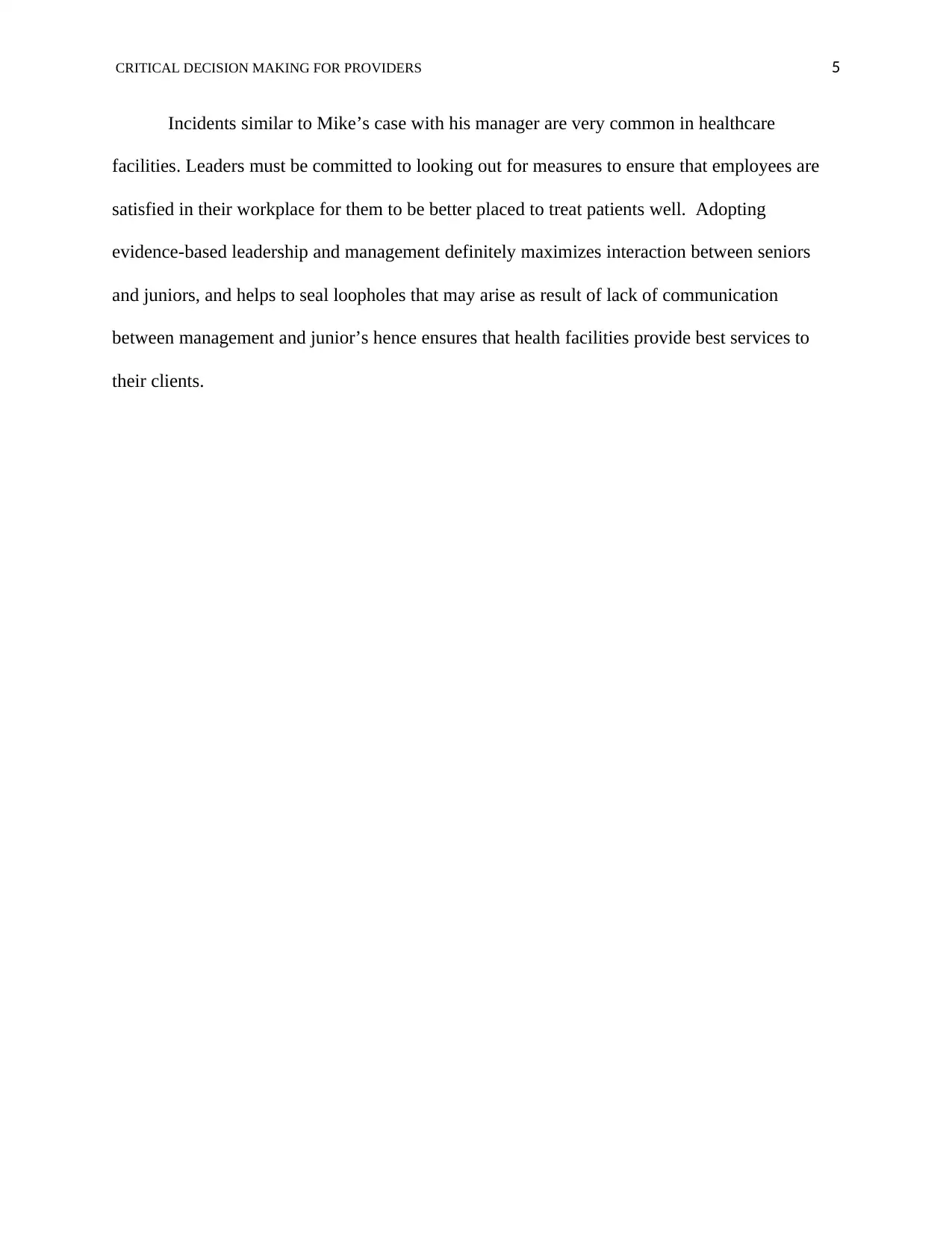
CRITICAL DECISION MAKING FOR PROVIDERS 5
Incidents similar to Mike’s case with his manager are very common in healthcare
facilities. Leaders must be committed to looking out for measures to ensure that employees are
satisfied in their workplace for them to be better placed to treat patients well. Adopting
evidence-based leadership and management definitely maximizes interaction between seniors
and juniors, and helps to seal loopholes that may arise as result of lack of communication
between management and junior’s hence ensures that health facilities provide best services to
their clients.
Incidents similar to Mike’s case with his manager are very common in healthcare
facilities. Leaders must be committed to looking out for measures to ensure that employees are
satisfied in their workplace for them to be better placed to treat patients well. Adopting
evidence-based leadership and management definitely maximizes interaction between seniors
and juniors, and helps to seal loopholes that may arise as result of lack of communication
between management and junior’s hence ensures that health facilities provide best services to
their clients.
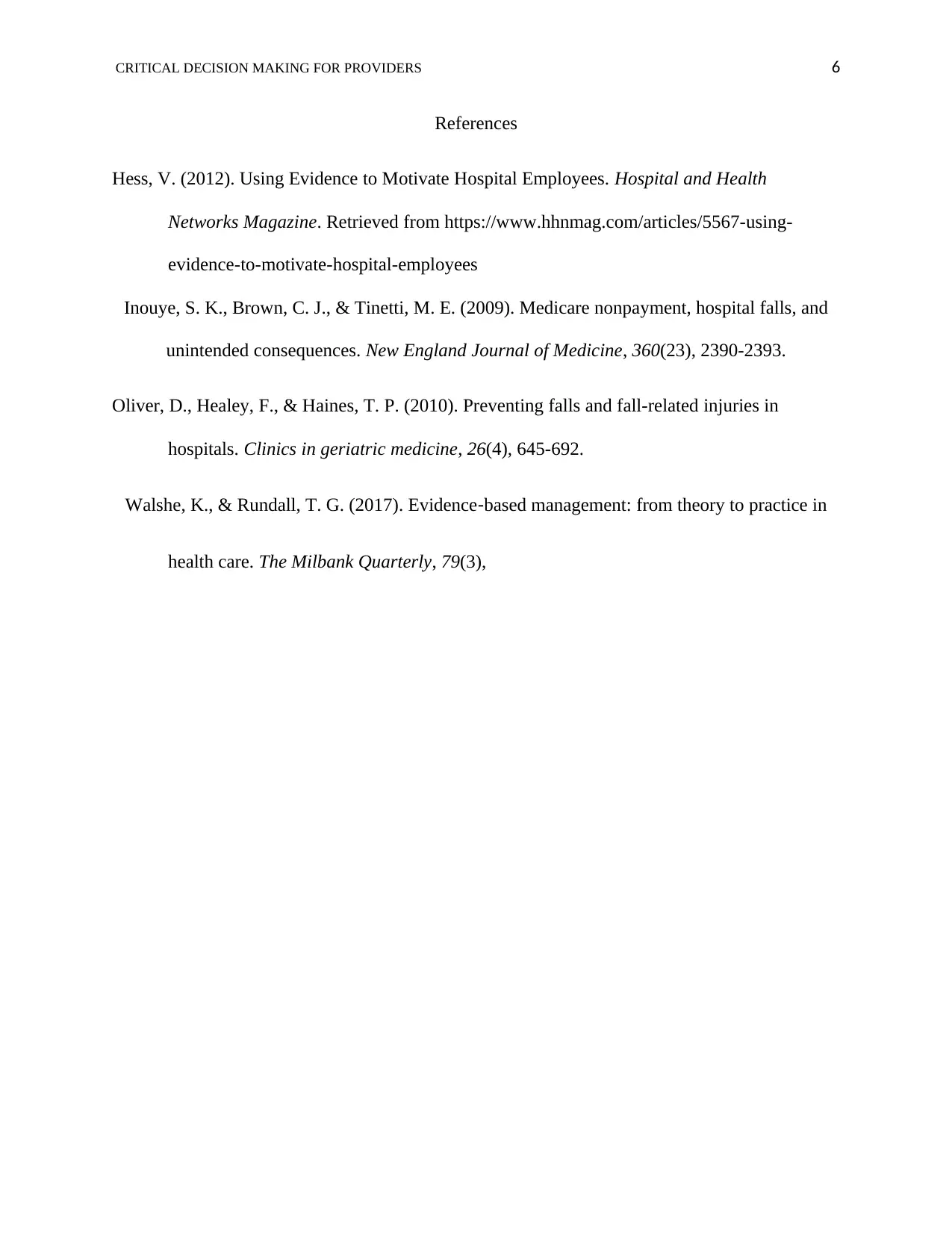
CRITICAL DECISION MAKING FOR PROVIDERS 6
References
Hess, V. (2012). Using Evidence to Motivate Hospital Employees. Hospital and Health
Networks Magazine. Retrieved from https://www.hhnmag.com/articles/5567-using-
evidence-to-motivate-hospital-employees
Inouye, S. K., Brown, C. J., & Tinetti, M. E. (2009). Medicare nonpayment, hospital falls, and
unintended consequences. New England Journal of Medicine, 360(23), 2390-2393.
Oliver, D., Healey, F., & Haines, T. P. (2010). Preventing falls and fall-related injuries in
hospitals. Clinics in geriatric medicine, 26(4), 645-692.
Walshe, K., & Rundall, T. G. (2017). Evidence‐based management: from theory to practice in
health care. The Milbank Quarterly, 79(3),
References
Hess, V. (2012). Using Evidence to Motivate Hospital Employees. Hospital and Health
Networks Magazine. Retrieved from https://www.hhnmag.com/articles/5567-using-
evidence-to-motivate-hospital-employees
Inouye, S. K., Brown, C. J., & Tinetti, M. E. (2009). Medicare nonpayment, hospital falls, and
unintended consequences. New England Journal of Medicine, 360(23), 2390-2393.
Oliver, D., Healey, F., & Haines, T. P. (2010). Preventing falls and fall-related injuries in
hospitals. Clinics in geriatric medicine, 26(4), 645-692.
Walshe, K., & Rundall, T. G. (2017). Evidence‐based management: from theory to practice in
health care. The Milbank Quarterly, 79(3),
⊘ This is a preview!⊘
Do you want full access?
Subscribe today to unlock all pages.

Trusted by 1+ million students worldwide
1 out of 6
Related Documents
Your All-in-One AI-Powered Toolkit for Academic Success.
+13062052269
info@desklib.com
Available 24*7 on WhatsApp / Email
![[object Object]](/_next/static/media/star-bottom.7253800d.svg)
Unlock your academic potential
Copyright © 2020–2025 A2Z Services. All Rights Reserved. Developed and managed by ZUCOL.





